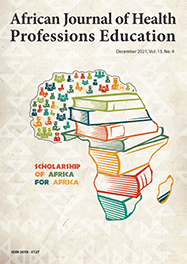Research

Teaching and learning considerations during the COVID-19 pandemic: Supporting multimodal student learning preferences
Abstract
Background. The advent of COVID‐19 and the subsequent national lockdown has catapulted higher education institutions into emergency remote teaching (ERT). A principal challenge in this shift is the ability to stimulate student interest towards engagement with, and retention of, course content. The creation of teaching and learning (T&L) resources and activities using a combination of the visual, aural, read/write and kinaesthetic (VARK) modes is fundamental in ensuring student engagement.
Objectives. To determine the learning style profiles of undergraduate students and to explore how student learning profiles may be incorporated in T&L approaches during ERT.
Methods. This descriptive study profiles the learning preferences of undergraduate students in a health science faculty using the VARK questionnaire. The study further outlines modifications in T&L implemented to support the varied learning preferences during the COVID‐19 ERT response.
Results. Our findings demonstrate that the majority of our students have a multimodal learning preference, with the kinaesthetic modality being the most preferred. Voice‐over PowerPoint presentations with transitioning images, and audio files, supported the visual and aural learners through asynchronous engagement. Additionally, online discussion forums and applied projects (such as theme park designs) enhanced asynchronous learning by stimulating the visual, read/write and kinaesthetic preferences, respectively. Microsoft Team sessions with PowerPoint presentations supported visual and aural learning preferences through synchronous engagement.
Conclusions. Rethinking traditional T&L approaches towards supporting the diverse student learning preferences is critical in student‐centred T&L amidst the many challenges that ERT has precipitated. Academics need to be dynamic in their T&L approaches and intuitive in their awareness of how subject content may be modified/enhanced in the ERT environment.
Authors' affiliations
F Ally, Department of Basic Medical Sciences, Faculty of Health Sciences, Durban University of Technology, South Africa
J D Pillay, Department of Basic Medical Sciences, Faculty of Health Sciences, Durban University of Technology, South Africa
N Govender, Department of Basic Medical Sciences, Faculty of Health Sciences, Durban University of Technology, South Africa
Full Text
Cite this article
Article History
Date published: 2022-02-22
Article Views
Full text views: 2964




.jpg)
Comments on this article
*Read our policy for posting comments here